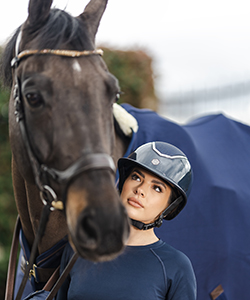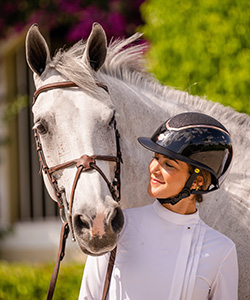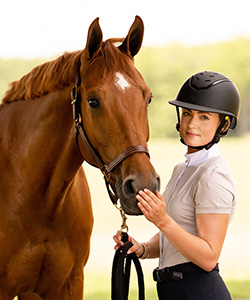Advertisement: Choosing the right helmet size is crucial when it comes to safety and comfort when riding. A well-fitting riding helmet not only provides protection against possible head injuries, but also contributes significantly to the rider’s overall well-being and confidence. In this article, you will learn important tips and information from Charles Owen experts on how to determine the optimal helmet size for you. From measuring methods to buying tips — learn how to find the perfectly fitting riding helmet with a size chart and you will also find out which riding helmets we recommend.
Riding helmet size chart: That is why it is important that the helmet fits properly
A correctly fitting riding helmet is not simply a regulation or a fashion accessory, but an indispensable piece of riding equipment that contributes significantly to safety. The importance of a well-fitting helmet cannot be overemphasised, as it protects the rider’s head in the event of a fall or accident. What we must not forget is that riding can also harbour certain dangers and can lead to injuries in the event of a fall. The head houses the brain, a vital organ, and is extremely vulnerable to injury.
A helmet that is too loose could slip or even fall off in the event of a collision, significantly reducing protection. A helmet that is too tight, on the other hand, can be uncomfortable, cause headaches and, in an emergency, lead to pressure points or even injuries. Only an optimally fitted helmet offers the best possible protection against serious head injuries, especially concussions or worse.
Therefore, it is crucial to find the right helmet size and make sure it is properly fitted and adjusted before you get in the saddle. This simple step can make the difference between life and health and should be considered essential by every rider.

Choosing the right riding helmet is important because the correct fit can save lives in an emergency.
How to measure and fit a riding helmet
Measuring a riding helmet is not always easy. We give you a few tips to help you find the right size!
Prepare tools:
- A flexible measuring tape
- A mirror (optional)
Positioning the measuring tape:
- Stand in front of the mirror to make the process easier.
- Hair should ideally be worn in a low pony tail (if applicable)
- Position the measuring tape about 2.5 cm (1 inch) above the eyebrows and around the widest part of the back of the head.
Measure the circumference of the head:
- Hold the tape measure horizontally around the head so that it goes across the forehead, along the temples and across the back of the head.
- Make sure the tape measure is tight, but not too tight, on the head.
Reading the measurement:
- Read the circumference once the tape measure has gone all the way around the head.
- Record the measurement in inches and centimetres.
Determining the helmet size:
- Compare the measured head size with the size chart of the respective helmet to find the appropriate helmet size, this will provide you with a good starting point.
It is advisable to take the measurement several times to make sure it is accurate. Trying on different helmets is also important to determine which helmet fits best and provides the desired comfort. If you are unsure, you can also consult an expert. Charles Owen, for example, offers a comprehensive online service to help you make the right choice.
They also created a clear and detailed video in which you can see once again what you need to pay attention to when measuring:
How should a horse helmet fit?
A horse helmet should fit snugly on the head, covering the forehead and back of the skull, without causing pressure points or discomfort.
Finding the right helmet – Things to check
When looking for the perfect riding helmet, careful consideration is crucial to ensure optimal safety and comfort. First, check the helmet’s certification to ensure it meets current safety standards. A certified helmet is the first step towards reliable head protection.
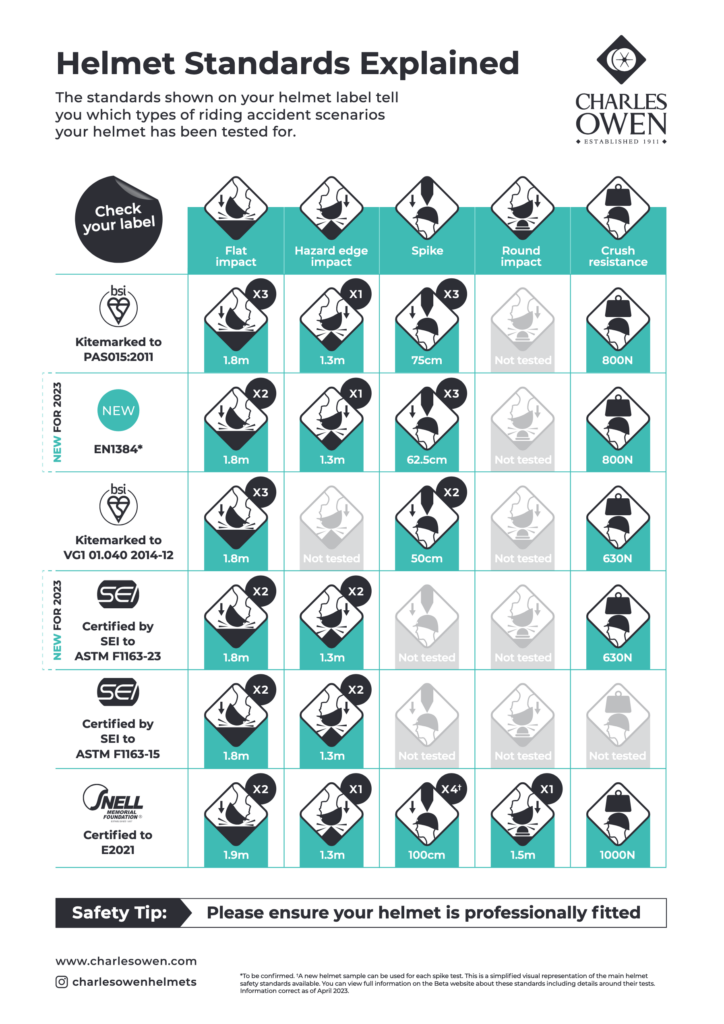
The more standards your hat has, the more accident scenarios you are covered for. 95% of Charles Owen helmets are certified to three international safety standards.
Next, the fit is crucial. The helmet should fit snug on the head without any specific pressure points, sitting one fingers width above the eyebrows. If you experience any specific pressure points, this can lead to headaches. You can test the fit of a hat by applying pressure at the front of the helmet and move it up and down. The helmet should not move independently from your head, it should make your eyebrows move up and down with the helmet.
Furthermore, the helmet’s adjustment system should be checked. A good quality riding helmet will offer an easy adjustment system to allow for a custom fit. This can include a dial fit at the back of the hat or laces at the back of the hat.
In addition, check the ventilation system as adequate ventilation is helpful for comfort while riding. A well-ventilated helmet helps prevent overheating and keeps you comfortable.
Charles Owen provides some additional useful tips:
- The helmet should provide a snug fit, applying consistent and firm pressure around the entire head.
- There should be no specific pressure points or gaps in the fit.
- The helmet should securely fasten at the back of the skull. Ensuring the dial fit is tightened correctly (if applicable) or the laces are fastened correctly (if applicable).
- Ensure the helmet sits level on the head, covering the forehead and leaving approximately an inch above the eyebrows.
- With the harness unfastened, the helmet should neither tilt forwards nor backwards.
- The chin strap should be fastened securely with one finger width under the chin.
- You should be able to insert a finger between the strap and your chin.
- The harness lace or dial at the rear of the helmet should be tightly secured.
- Allow the helmet to mold to your head by wearing it for 5 minutes, checking for any pressure points during this time.
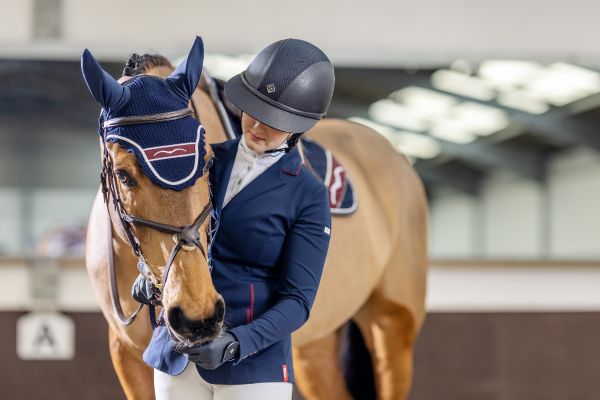
The perfect riding helmet fits tightly, but not too tightly. The individual head shape must also be taken into account when measuring.
Perfectly fitting riding helmet: Size chart
But how do I find the right helmet size? To determine the optimal helmet size, it is important to measure the head circumference correctly. You can see how this works in the above video by Charles Owen, among others.
This riding helmet size chart lists the common helmet sizes with the corresponding head circumference ranges in inches and centimetres. This chart serves as a useful reference to assist riders in selecting the appropriate helmet.
| Helmet size | Head circumference in inches | Head circumference in centimetres |
|---|---|---|
| XS | 20 – 20 3/4 | 51 – 53 |
| S | 21 – 21 1/2 | 54 – 55 |
| M | 21 3/4 – 22 1/4 | 56 – 57 |
| L | 22 1/2 – 23 | 58 – 59 |
| XL | 23 1/4 – 24 | 60 – 61 |
| XXL | 24 1/4 – 24 3/4 | 62 – 63 |
How to measure an fit a riding helmet?
To measure and fit a riding helmet, measure the circumference of your head above the eyebrows, choose the appropriate size using the manufacturer's size chart, and ensure a snug and comfortable fit without any pressure points.
Riding helmet size chart – Round or oval head?
For riders with a round head, it is important to choose a helmet that has enough room in the width to avoid pressure points. The helmet should fit snug with no specific pressure points. If you feel pressure at the side of your head, you are more likely to be a round fit.
For riders with an oval head, a helmet with an elongated shape and corresponding volume on the sides is a better choice. It is important that the helmet covers the head well from front to back and does not feel too tight at the sides.

Regardless of the head shape, helmet adjustment is essential. Adjusting the harness system and other fitting options should be done carefully to ensure the best fit and thus the best possible protection.
Ultimately, it is advisable to try out different designs and, if necessary, seek professional advice to find the helmet that suits both head shape and personal comfort. Safety should always be a top priority and a well-fitting helmet is an essential part of this.
Above you can see a detailed Charles Owen Size Chart to help you choose the right size.
Children’s Riding Helmet Size Chart
Children’s riding helmets are of great importance to ensure the safety and comfort of young riders. These helmets are specially designed to protect children’s heads while encouraging their enjoyment of riding. They are available in a variety of sizes to accommodate children’s different head circumferences and shapes. In addition, many children’s riding helmets feature vibrant colours, child-friendly designs and sometimes even removable padding to adjust the helmet and keep it clean. When choosing a children’s riding helmet, it is essential to look for the right fit, certifications and quality to ensure the best possible safety for little riders.
Parents and carers should ensure that the helmet is fitted correctly and worn at all times while riding. As children grow quickly, it is also important to check the correct size and fit regularly.
By the way: Most Charles Owen helmets are also available in children’s sizes! Be sure to check out the large assortment.
Riding helmet size chart: Conclusion and product recommendation
Overall, choosing the right riding helmet is very important for the safety, comfort and well-being of every rider. A well-fitting helmet provides protection against head injuries and is therefore essential for riders of all ages and experience levels. Even the most loving horse can get spooked in an emergency, which can lead to a fall. When choosing a helmet, the individual head shape should be taken into account, be it a round or oval head. The fit, certification, quality and adjustment system of the helmet are important factors that need to be carefully considered. Ultimately, the helmet should fit comfortably, be correctly adjusted and meet current safety standards. Safety should always be the top priority.
In this context, we recommend the quality riding helmets from Charles Owen. These riding helmets are for every rider, regardless of discipline or the shape of your head. Ride with confidence knowing that every Charles Owen riding is tested to the highest safety standards with the highest quality.
All major equestrian sporting bodies require riders to wear riding helmets that meet minimum safety standards. 95% of Charles Owen helmets meet at least three international safety standards.
Charles Owen’s helmet sizing caters for every head shape. In addition, the high-quality helmets from Charles Owen come in a wide variety of designs, so that there is a favorite piece for every rider in every discipline.
Sounds exciting? Then take a look at the wide range of Charles Owen riding helmets now!
